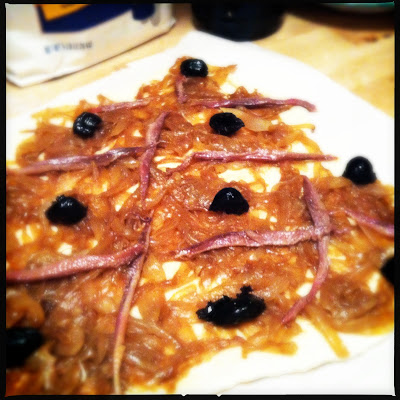Monday, September 10, 2012
Pissaladiere
Pissaladiere, pissaladiere, pissaladiere. It's one of my favorite pizzas, and it's not even Italian. It comes from Provence, with different versions along Côte d'Azur (the French Riviera.) Some versions use flaky pastry, some versions are thick and bready, but my kind of pissaladiere is paper thin with caramelized onions.
 Every time I go to Provence, there are three dishes I Must eat: pissaladiere, tartar de boeuf (beef tartar) and brandade de morue (whipped salt cod and potatoes). I had read about pissaladiere on Wikipedia (of all places!), I believe, even before my first trip to Provence.
Every time I go to Provence, there are three dishes I Must eat: pissaladiere, tartar de boeuf (beef tartar) and brandade de morue (whipped salt cod and potatoes). I had read about pissaladiere on Wikipedia (of all places!), I believe, even before my first trip to Provence.
 Every time I go to Provence, there are three dishes I Must eat: pissaladiere, tartar de boeuf (beef tartar) and brandade de morue (whipped salt cod and potatoes). I had read about pissaladiere on Wikipedia (of all places!), I believe, even before my first trip to Provence.
Every time I go to Provence, there are three dishes I Must eat: pissaladiere, tartar de boeuf (beef tartar) and brandade de morue (whipped salt cod and potatoes). I had read about pissaladiere on Wikipedia (of all places!), I believe, even before my first trip to Provence.
I tried it for the first time at my favorite restaurant on Cours Mirabeau in Aix en Provence and though the onions there were not caramelized, I loved it. Crispy and salty, the combination of onions, rich black olives and salty and slightly bitter anchovies got me hooked instantly.
And the cafeteria at la Méjane library in Aix has a cheap but very good tartar de boeuf. (They have pretty good desserts too!) The best brandade de morue was at a small but excellent cafe in the tiny village of Le Poët-Laval (this is actually in Drôme, not Provence) - I had ordered a salad and it was topped with four slices of baguette with an indescribable fluffy emulsion on it, the tops barely browned and the inside creamy. If I hadn't been told, I wouldn't even have guessed there was salted cod in it.
But I digress.
Today I show you Pissaladiere - the lovely pizza that almost no one here seems to know.
Ingredients are simple:
2 pounds onions (or a bit more), sliced as thinly as possible - you can use a mandoline slicer if you like
3 tablespoons olive oil
1 teaspoon brown sugar
1/4 teaspoon salt
half a can of anchovies
about 4 oz. of black olives - pitted, or pit them yourself
and about 1 pound pizza dough - buy some or make your own.
I'm not going to tell you now to preheat your oven, because then you'll keep that oven going for several hours. There's no shortcut to caramelizing onions.
It doesn't really matter how you slice the onions - rings or not, it makes no difference after you have been frying them for 60 minutes or so. Just pour the olive oil in a pan and start cooking the onions over medium heat. I find it easier to leave the onions untouched for the first five minutes, then flip them over to the best of my ability and leave them for another five, until slightly softened. Stirring around crunchy onions inevitably leads to a lot of onions falling out of the pan.
You can also put the lid on for the first five or ten minutes to get the onions to wilt faster. Turn the heat lower, to about medium low, after the onions have silted and softened.
Seriously, watch the pan and don't let it burn. You can turn your back to it and wash some dishes, but don't walk away. This is after 20 minutes.
This is after 30 minutes. I add the salt and a bit of sugar to accentuate the sweetness of the onions and also to accelerate the caramelizing process. Continue stirring.
This is after 50 minutes. Not there yet, by my standards.
This is after approximately an hour - done.
A couple of pounds of onions may seem like a lot, but they will reduce to less than a cup.
Now, preheat your oven to 400F.
Roll out your pizza dough as thinly as possible. Spread your caramelized onions in a thin layer. (yes, the dough can show through in some places, because these onions are full of flavor by now.) I think by now you would be rather attached to these onions. After all, you've slaved over them for an hour.
With a small sharp knife, I cut along the spine of the anchovy fillets to get even thinner slivers. You can use them whole, but I find that overwhelmingly salty.
Arrange in a crisscross pattern, and put a black olive in each square.
Bake in the middle or lower rack of your oven for 10 to 15 minutes, until your pizza crust is crisp. Serve immediately. Revel in the complexity of flavor.














0 comments:
Post a Comment